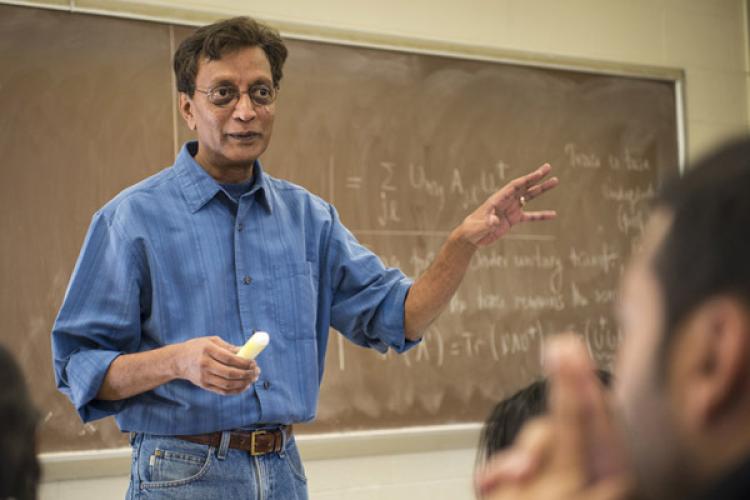
Madappa Prakash awarded most prestigious prize in nuclear astrophysics

The American Physical Society awarded Dr. Madappa Prakash the 2022 Hans A. Bethe Prize, the most prestigious prize in the field of nuclear astrophysics, for his research about neutron stars and black holes.
Prakash, professor in the Physics and Astronomy Department in the College of Arts and Sciences at Ohio University, was recognized “for fundamental contributions to the physics of hot and dense matter, and their implications for heavy ion collisions and multi-messenger observations of neutron star structure and evolution,” said the prize citation.
“Prakash has played a pivotal role in the physics of neutron stars and heavy-ion collisions over his long and prolific career,” Dr. Zachary Meisel, associate professor of physics, said. “A direct line can be drawn between Prakash’s contributions in nuclear theory and major advances in astrophysics.”
Prakash joined Ohio University in 2005 as a full professor, in part to be the “glue” between the different research areas pursued by the Institute of Nuclear and Particle Physics and the Astrophysical Institute under the sponsorship of Ohio University's research priority program “Structure of the Universe: From Quarks to Super-Clusters.”
“This is a well-earned honor for Prakash, who is a leader in his field,” Dr. David Ingram, professor and department chair, added.
Prakash's research has covered many of the myriad phenomena that occur in nuclei and in nuclear matter under extreme conditions of density, temperature and magnetic fields. His work has illuminated the role of the equation of state of dense matter in nuclear collisions from low to very high energies and the structure of neutron stars.
Investigations of strangeness-bearing matter led him to discover new pathways to form stellar mass black holes from metastable neutron stars. His work includes the evolution of neutron stars from their birth to old age, neutrino interactions and propagation in dense astrophysical systems, and the theoretical interpretations of the growing number of observations of neutron stars. He develops equations of state, neutrino opacities, and transport characteristics in dense matter for studies of supernovae and binary mergers involving neutron stars and black holes.
More specifically, his major achievements include elucidating the connection between the maximum observed neutron star mass and the dense matter equation of state, identifying the constraints that an observed core collapse supernova neutrino signal will place on the composition and structure of protoneutron stars, and connecting neutron star radius observations to the density dependence of the nuclear force.
Other major achievements include establishing the theoretical framework connecting heavy-ion collision flow measurements and the dense matter pressure-density relationship, providing the physical basis for the hadron-resonance gas often used to compare relativistic heavy-ion collision data to lattice quantum chromodynamics calculations of the hadron-to-quark cross-over transition, and laying the theoretical foundation required to show that relativistic heavy ion collisions exhibit perfect fluid behavior.
“Prakash’s impact is multiplied by his significant research mentorship: 14 Ph.D.s and 31 undergraduate researchers. This includes work that has strong promise for impacting future astrophysics research; e.g., detailing the gains that can be realized in understanding the dense matter equation of state by future measurements from NICER (NASA's Neutron Star Interior Composition Explorer) and LIGO (the Laser Interferometer Gravitational-Wave Observatory),” Meisel said.
Prakash earned his Ph. D. degree in physics from the University of Bombay (1979) while he was employed at the Bhabha Atomic Research Center in Bombay. His post-doctoral studies were conducted at the Niels Bohr Institute in Copenhagen (1979-81) and Stony Brook University (1982-86), where he taught and engaged in research until 2005.
In 2001, Prakash was elected a Fellow of the American Physical Society (Division of Nuclear Physics) “for fundamental research into the properties of hot and dense matter, providing a basis for understanding relativistic heavy ion collisions and the structure and composition of neutron stars.”
